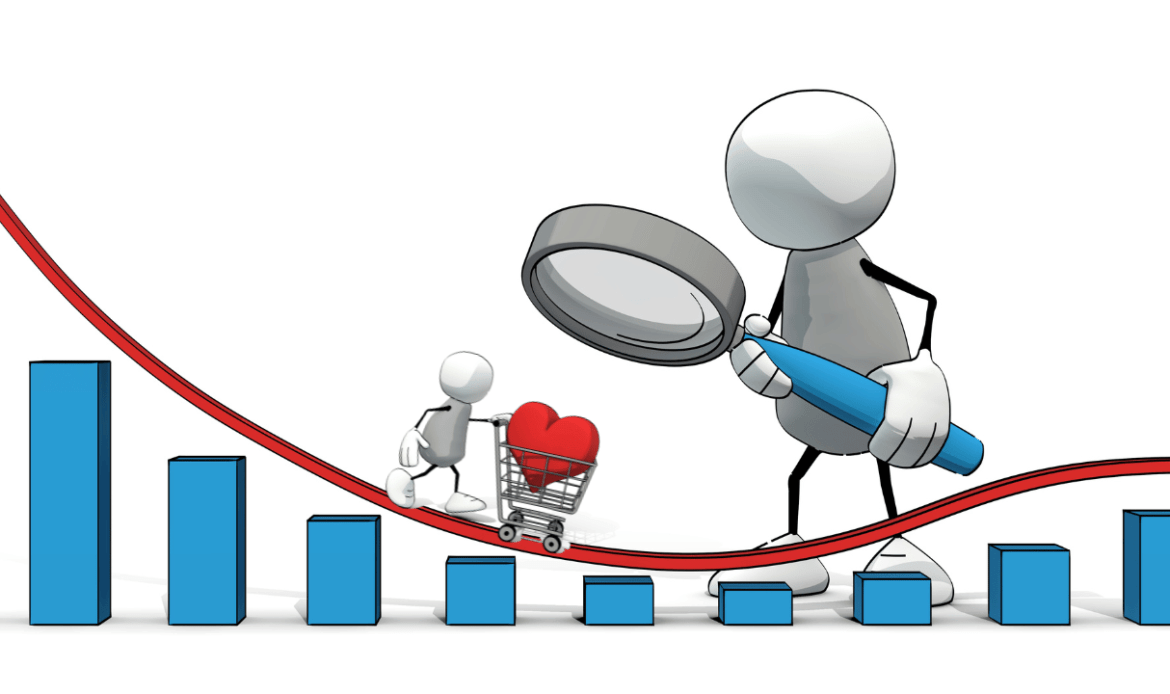Despite its tempering, inflations heavy hand will be here for some time to come. The perceptions grocers leave inside their customers will impact them beyond any resetting of prices and images. That makes it critical for supermarket retailers to get pricing right, not because of competition, but because of their customers.
According to the USDA, consumers have spent 11.3% of their disposable income on food, the most since 1991 when it was 11.4%. And despite the inflation tempering, grocery costs are up 1.2% from January to February. But don’t expect it to come down anytime soon. Grocery prices typically never go down and have long-term impacts. For example, the U.S. Agriculture Department stated that in 1991, households were still dealing with steep food-price increases following the inflationary period in the 1970’s.
Before last year’s historic rise in inflation, U.S. consumers were accustomed to steady inflation of ~2%/yr over the previous 10 years and 3%/yr in the 20 years before that. Gen X, Millennials, and Gen Z consumers have never seen price shocks. And for Baby Boomers, it was a distant memory that occurred early in their careers. Consumers must reset their price anchor to the new reality, and that won’t happen quickly.
Today’s reports show that price expectations aren’t even close to being aligned. Consumers recall when butter was $1.89, but now it’s $3.50. Or a pound of peaches went from $1.89 to $2.99. Need more confirmation? Just look at the graph below, which demonstrates the shock.
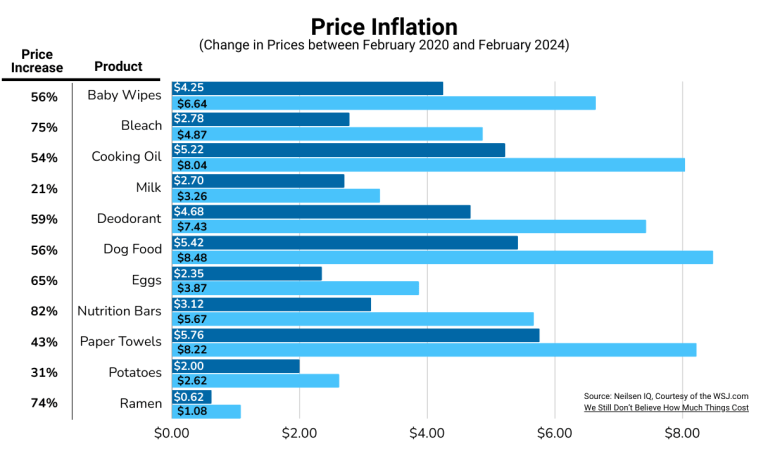
During the pandemic, amid supply chain disruptions, worker shortages, and surging demand, people understood paying more, but prices were still increasing. While inflation is coming down, it has remained stubborn, hovering between 3%-4% since May 2023—above the U.S. feds’ target of 2%.
Consumers viewed price hikes as temporary. “The fact that they’re not and they’re continuing to go up is frustrating.
Stephanie Tully, Professor at the University of Southern California’s Marshall School of Business
Source: WSJ.com, We Still Don’t Believe How Much Things Cost
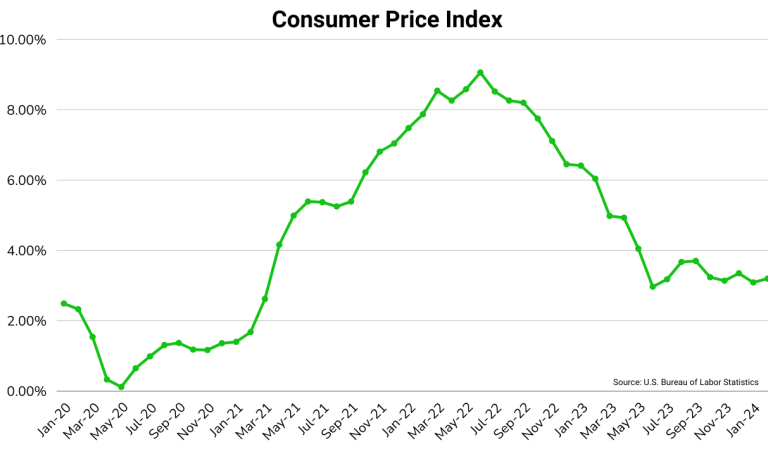
Shrinkflation isn’t helping either, to the point that Senator Bob Casey is getting involved. He released government data which he said shows that some CPG companies try to mask inflation by quietly downsizing product sizes without adjusting prices or clearly notifying consumers. In a follow-up report, he also expressed that from July 2020 through July 2022, inflation rose by 14 percent while corporate profits rose by more than 74 percent—nearly five times the inflation rate. While politics can play an angle, it does reflect consumer sentiment (and Cookie Monster’s feelings.)

Yet the sentiment is backed by financial facts. People’s financials are taking a hit. As of mid-2021, U.S. consumers had over $2 trillion in savings, a peak from the pandemic. In November 2023, that number was $321 billion. More importantly, the excess savings drawdowns have been relatively even across income groups. Additionally, this is happening during a period of very low unemployment, the latest reading being 3.9% in February, up a tick from 3.7% in January. So people are working and falling behind.
401k plans offer another data point. Despite higher savings in 2023 into retirement accounts, 401k hardship withdrawals are up. Around 3.6% of 401(k) participants pulled money from their accounts, compared to 2.8% in 2022 and above the pre-COVID-19 pandemic average of about 2%.
Finally, despite all the stimulus money, low unemployment, and tempering inflation, consumers have never, once in the last four years, felt as optimistic about the overall state of the economy or their personal financial situation as they did before the pandemic. However, their optimism did fall to all-time lows in June 2022.
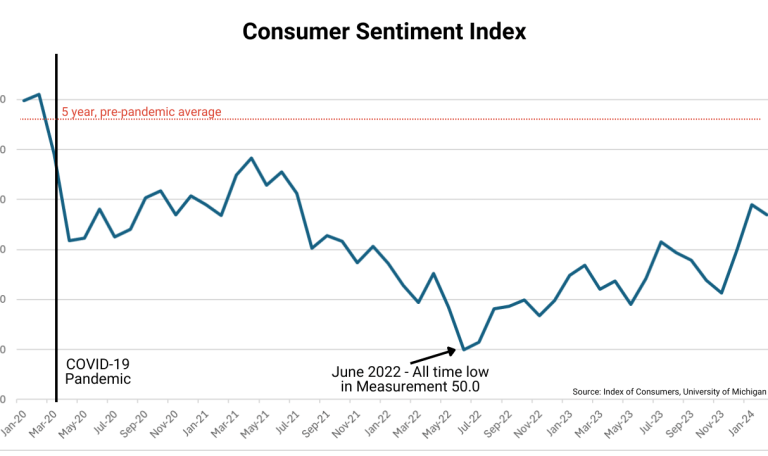
Consumers are feeling the pain of inflation and becoming frustrated with continued high prices. These financial pressures force consumers to reduce spending, switch to cheaper brands, shop around for discounts, and buy fewer non-essential items.
Grocers need to take a customer-centric approach to pricing. Doing that requires answering straightforward questions, but getting the answers is complicated without advanced science.
- What items do your customers care about, and how are those items affecting your business’s price/value perception?
- When the price increases or decreases, how does that affect the sales of that product?
- How do customers react to your promotions? What is the lift from the offer and the ad placements?
- How do the previous answers differ by market or store?
- How are the answers changing over time?
Most retailers start pricing based on cost, margin, brand, size, and competitive rules. While these are important, none of them look at the customer.
Understanding how your customer demand changes relative to price or the price elasticity can help you decipher the pricing opportunity. On visualization of this is an opportunity curve where you plot an item’s price range across the revenue and profit impacts. Then, plot where your item’s current price to see what the potential benefit of a price change is. You can also take another step and graph how your current pricing rules shrink the overall opportunity. The end visualization is the equivalent of picking a point on a graph.
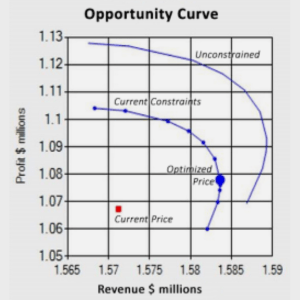
While this is a great visualization, the power comes from
- Analyzing every item within your assortment
- Across every location and
- Updating it over time as consumer preferences shift.
This allows you to set the best prices for your enterprise according to your strategy and goals.
Looking to grab some additional market share and where you can lower prices without destroying your profitability? Did your vendors raise costs, and you want to determine where you can save some of your margins while still being ultra-competitive? This analysis is the foundation of answering those questions. It balances the trade-offs.
Both consumers and grocers are dealing with the impacts of higher costs and inflation. Consumers see more of their income covering food expenses and their savings dwindling. Grocers are coping with higher operational costs, rapidly shifting consumer spending behaviors, and pressure to find profits without alienating their customers. Unfortunately, none of these pressures will leave anytime soon.
Yet by taking a consumer-centric approach and listening to the signals that consumers give with every purchase decision, grocers can align their prices to customers’ expectations while ensuring healthy profits. Consumers have never been against businesses making a profit; they want fair, competitive prices that justify the value.

Mark Schwans
Mark Schwans has over 25 years experience within retail technology, marked by leadership roles at Oracle, Accenture, Revionics, antuit.ai, Zebra Technologies, and Newmine.
His extensive background spans diverse domains such as strategy, consulting, implementation, enablement, and marketing.
Mark’s impact is defined by research, adept storytelling and potent visuals to provide digestible insights with a distinct perspective of the retail landscape.

